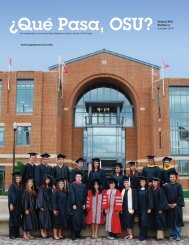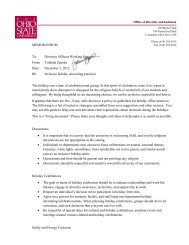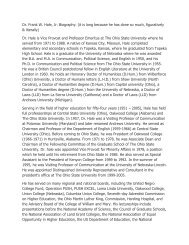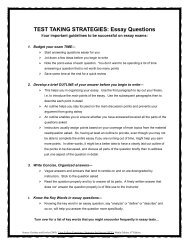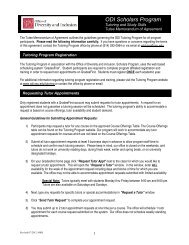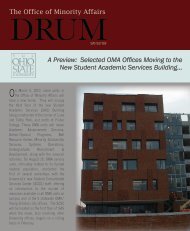Qué Pasa, OSU? - go to site
Qué Pasa, OSU? - go to site
Qué Pasa, OSU? - go to site
- No tags were found...
You also want an ePaper? Increase the reach of your titles
YUMPU automatically turns print PDFs into web optimized ePapers that Google loves.
Northern In-HospitalityNAFTA’s Effect on Sex Trafficking in the AmericasBy Colleen Durfee, Junior, Department of Geography; Department of Spanish and PortugueseRelations between the United States andLatin America affect every aspect of LatinAmerican and United States citizens’ lives, afact enhanced by the increasing migrationof peoples and the expansion of neo-liberalmarkets between these countries. Arguably,past and present relationships betweenLatin America and the United States, specificallywith trade agreements that link thetwo regions, have been an axis of leverage<strong>to</strong> exercise political and economic control,and may be connected <strong>to</strong> the sex tradeof women and children throughout theUnited States. So how might foreign policy<strong>to</strong>ward Latin America change such thatpeople may survive in their countries oforigin without being pushed or pulled out?How can the economic, social, and politicalinequalities of Latino Americans at homebe mitigated so as <strong>to</strong> diminish the risks ofimmigration <strong>to</strong> the United States?These loaded questions have no clearanswer, but the sex-trafficking industry isthe most common and fastest growing formof slavery in the world <strong>to</strong>day. The U.S. CIAestimates that about 50,000 people are traffickedin<strong>to</strong> the United States annually andof those, 15,000 are Latin American womenand children. An answer <strong>to</strong> these questionsis pertinent <strong>to</strong> s<strong>to</strong>pping inhumane treatmen<strong>to</strong>f these women and children. Theaverage age of a sex-slave in the world is12 <strong>to</strong> 14 years old. They are abused androbbed of the security and intimacy that wehold dear. Sex trafficking is a manipulativeprocess that preys on the young, especiallywomen and girls, and is unfortunately theonly way for some <strong>to</strong> migrate from one area<strong>to</strong> another. The problems Latin Americansface when trying <strong>to</strong> immigrate <strong>to</strong> the UnitedStates increases illegal immigration throughunregulated, exploitative, and dangerousmeans and strengthens the power andinfluence of the sex-trafficking industry.This informal economy through humantrafficking is partially perpetuated throughthe United States’ employment of neo-liberalpolicies regarding trade. These policiesintend <strong>to</strong> “promote economic growth byspurring competition in domestic marketsand promoting investment from bothdomestic and foreign sources” say GaryClyde Hufbauer and Jeffrey J. Schott intheir article, “NAFTA Revi<strong>site</strong>d:Achievements and Challenges.”However, the subsequenteffects of NAFTA have inducedmass migration <strong>to</strong> small border<strong>to</strong>wns in northern Mexico,called maquiladoras. These<strong>to</strong>wns are pressured <strong>to</strong> expand<strong>to</strong> contain large populations,creating an environment ofresource scarcity that drives upthe cost of living. Many ruralfamilies once grew their ownfood but the agri-businesspropelled by NAFTA made itimpossible for them <strong>to</strong> supportthemselves or sell their productbecause the U.S. crop is muchcheaper. As the Mexican agriculturaleconomy is hollowed out, moreand more Mexicans move across the borderundocumented. This is just one example ofhow a family in Mexico finds it worth the riskof migrating <strong>to</strong> the United States <strong>to</strong> supporttheir family.The workers in these border fac<strong>to</strong>ries setup by free trade agreements are subject <strong>to</strong>contaminated water, environmental degradation,lead poisoning, gas poisoning, andmore. These hazards lead <strong>to</strong> early death,infertility, and cancer. The transnationalcorporations will outlast any legal appealfor damage compensation or severancepay after they outsource <strong>to</strong> East Asian areas,leaving the Mexican populations withtheir hands bound and no course of action<strong>to</strong>ward justice or equality. All of thesefac<strong>to</strong>rs lead <strong>to</strong> the push and pull effect thatcontributes <strong>to</strong> dangerous labor migrationacross a highly militarized border.The defense budget for border regulationand maintenance has ceased <strong>to</strong> beofficially reported for after 2002 when itreached 2.1 billion per year. However, theestimated cost now surpasses 10 billionper year, post-2010. Fewer people haveattempted crossing the border due <strong>to</strong> thehigher risk involved in crossing. The effec<strong>to</strong>f a highly militarized border is <strong>to</strong> forcecrossing <strong>to</strong> occur through mountains ordeserts where death from extreme weatherand temperature is high. Many scholarsargue that this kind of border has theoppo<strong>site</strong> desired effect on immigration <strong>to</strong>the United States because once immigrantsenter; they do not want <strong>to</strong> leave. Previouslywith more fluid borders there were lessdeaths and less permanent residents inUnited States terri<strong>to</strong>ry resulting fromborder crossings <strong>to</strong> and form Mexico andthe United States.There are both known and unknowncontribu<strong>to</strong>rs <strong>to</strong> the proliferation of thedangers in immigration and exposure <strong>to</strong>human trafficking in the United States. TheUS holds much of the responsibility of theincreased violence resulting from foreignpolicy and free trade agreements with itsneighbors <strong>to</strong> the South. The effects of neoliberalismon the countries that bare thebrunt of the capitalist forces result in constantlycompeting corporate and privateforces for lower prices and higher profits.It takes no effort <strong>to</strong> see why maquiladoreshave thrived and caused suffering in thewake of consumer practices. America hasmade a mess by marginalizing billionsof people through NAFTA based on theneed <strong>to</strong> perpetuate an economic, capitalhegemony. Unfortunately, an entire cultureof exploitation has manifested in thehuman trafficking, slavery, and the agriculturaland industrial sec<strong>to</strong>rs of the US’ssouthern and Mexico’s northern states.For Colleen Durfee’s full essay with citationsvisit us on line: quepasa.osu.edu.www.quepasa.osu.edu Spring Semester 2013 19




